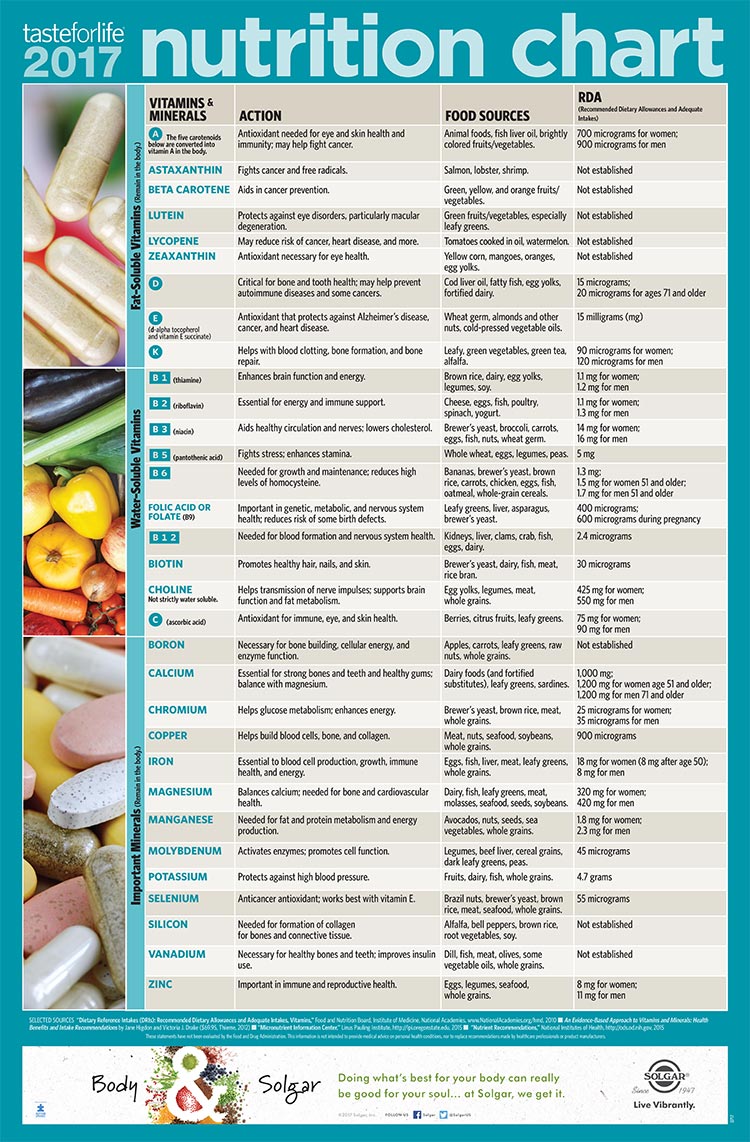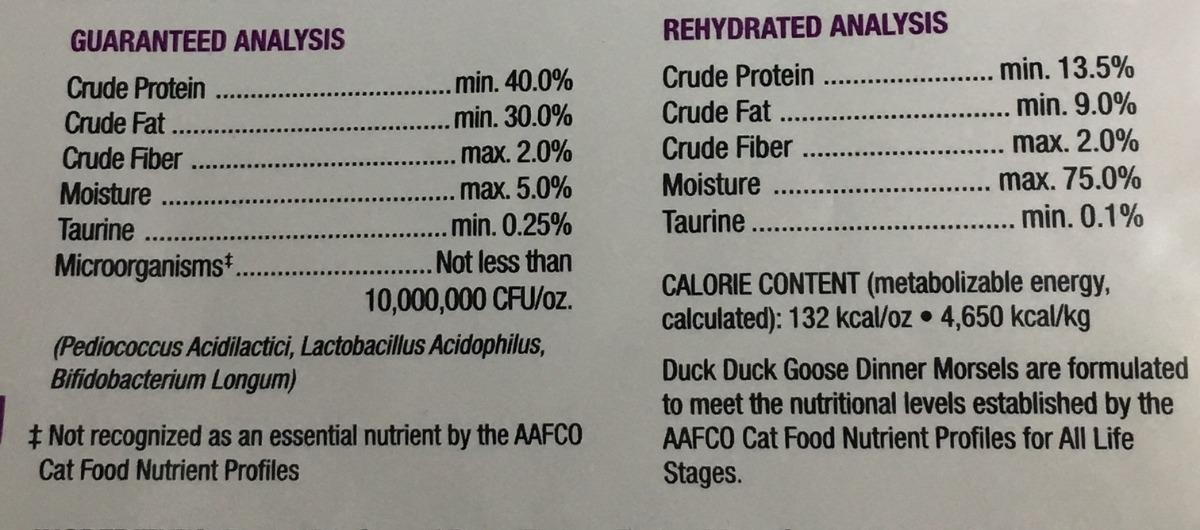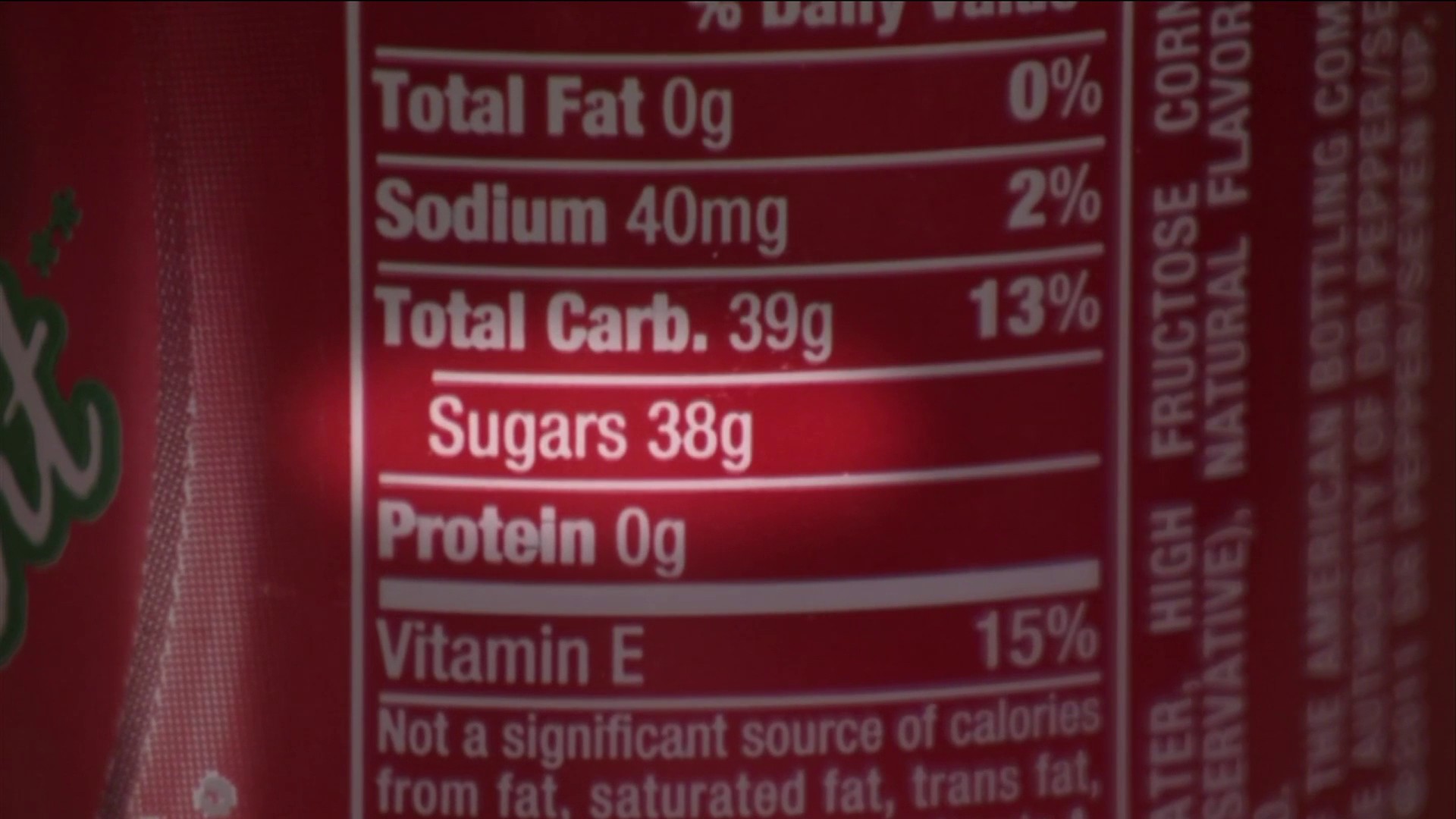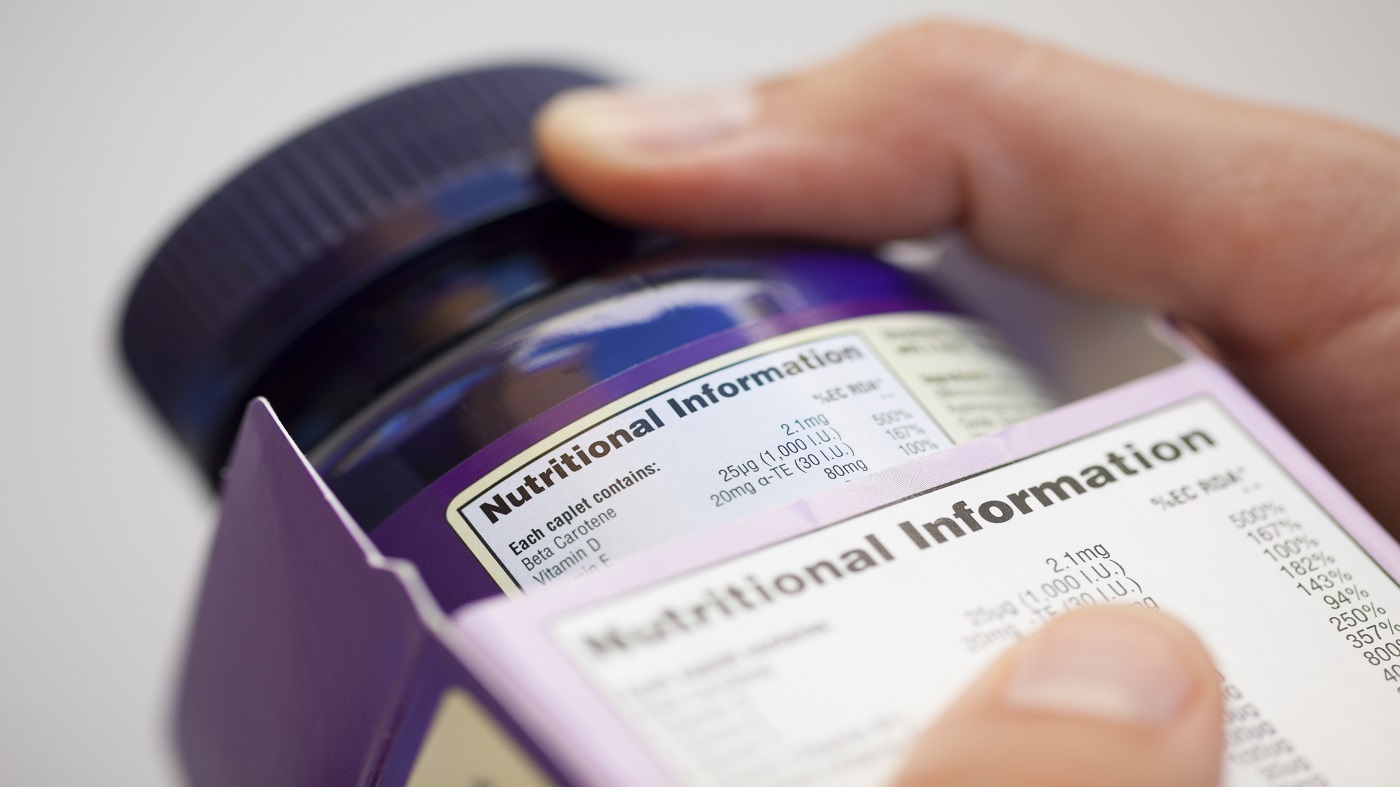43 vitamins and minerals on food labels
Vitamins and Minerals | Nutrition.gov Vitamins and Minerals Get the facts on vitamins and minerals, from A to Z. Food Sources of Calcium USDA, HHS View a list of common foods and drinks and the amount of calcium in a standard portion. Food Sources of Iron USDA, HHS View a list of common foods and drinks and the amount of iron in a standard portion. Food Sources of Potassium USDA, HHS Understanding Nutrition Facts on Food Labels - WebMD After fats, carbohydrates, dietary fiber, sugars, and protein are listed on the food label. These items are followed by specific nutrients in the food, such as vitamin A, vitamin C, calcium, and...
Dietary Supplement Labeling Guide: Chapter IV. Nutrition Labeling This results in the following order for vitamins and minerals: Vitamin A, vitamin C, vitamin D, vitamin E, vitamin K, thiamin, riboflavin, niacin, vitamin B6, folate, vitamin B12, biotin,...
Vitamins and minerals on food labels
New Food Label Spotlight: Vitamins and Minerals In the updated label, that same section will jettison vitamin A and vitamin C (the FDA asserts, "In the early 1990's, American diets lacked Vitamins A and C, but now Vitamins A and C deficiencies in the general population are rare"), replacing them with vitamin D and potassium. Calcium and iron will remain on the label. Food Labels | Nutrition.gov Folate and Folic Acid on the Nutrition and Supplement Facts Labels HHS, Food and Drug Administration, Center for Food Safety and Applied Nutrition Learn what common foods are natural sources of the vitamin folate, plus what foods may have folic acid added during processing. Interactive Nutrition Facts Label HHS, Food and Drug Administration Understanding Food Labels | The Nutrition Source | Harvard T.H. Chan ... Removal of vitamins A and C, and addition of vitamin D and potassium. Vitamins A and C had been included in previous labels when deficiencies of these nutrients were more common. They are rare today, so have been replaced with vitamin D and potassium, which can run low in the diets of some Americans. How do I use the % Daily Value?
Vitamins and minerals on food labels. How to calculate percents of vitamins and minerals on nutrition labels? In the Nutrition Facts label, which vitamins and minerals are listed? Biotin, choline, folate, niacin, pantothenic acid, riboflavin, thiamin, and vitamins A, b6, b12, c, d, e, and K are among the 14 vitamins that may be stated on the Nutrition Facts label. Minerals are inorganic substances present in soil and water naturally. Vitamins and minerals - British Nutrition Foundation Which foods are a good source of vitamins and minerals? Different foods provide different vitamins and minerals in varying amounts. Therefore, it is important to aim for a varied and balanced diet that includes foods from all food groups shown in the Eatwell Guide in appropriate amounts. ... When choosing vitamin D supplements, read the label ... Vitamins and minerals, explained | Center for Science in the Public ... Thiamin (B-1), Riboflavin (B-2), Niacin (B-3), and Vitamin B-6. The DVs for these B vitamins dropped slightly. Way-above-the-DV doses are useless but probably safe. Exceptions: levels over 35 milligrams of niacin from supplements can cause flushing of the skin and more than 100 mg of B-6 can cause (reversible) nerve damage and skin lesions. FDA Rounding Rules for Your Food Label - LabelCalc Vitamins and Minerals (Vitamin A, Vitamin C, Calcium, and Iron) If your product has: A vitamin or mineral value with less than 2% of the Recommended Daily Intake (RDI), it can be expressed in the following four ways: Zero; A statement that says something to the effect of, "less than 2% of the Daily Value for X nutrient."
Daily Value on the New Nutrition and Supplement Facts Labels Which Nutrients Are Required to Be Listed on the Nutrition and Supplement Facts Labels? The Nutrition Facts label must list total fat, saturated fat, trans fat, cholesterol, sodium, total... How to Read Supplement Labels Like a Pro - Healthline Regulations on supplements Dietary supplements are products that are intended to supplement your diet. They're available in a variety of forms, including tablet, capsule, liquid, pill, and powder.... Optional Nutrients On The Food Label - LabelCalc Dietary fiber. Sugars. Protein. Vitamin A. Vitamin C. Calcium. Iron. These nutrients are mandatory because the FDA considers them the most essential to either limit our intake of (in the case of cholesterol, sodium, and trans fat) or increase our intake of them (in the case of iron, Vitamin C, and dietary fiber). Figuring Out Food Labels (for Kids) - Nemours KidsHealth Food contains fat, protein, carbohydrates, and fiber. Food also contains vitamins, such as vitamin D, and minerals, such as calcium and iron. Your body needs the right combination of nutrients to work properly and grow. The Nutrition Facts label is printed somewhere on the outside of packaged food, and you usually don't have to look hard to ...
Where are the vitamins and minerals on a nutrition labels? The Nutrition Facts label may include the following 14 minerals: Calcium, chloride, chromium, copper, iodine, iron, magnesium, manganese, molybdenum, phosphorus, potassium, selenium, sodium, and zinc are some of the minerals found in the human body. On a nutrition label, how are ingredients listed? Food labeling: MedlinePlus Medical Encyclopedia VITAMINS AND MINERALS Vitamin D, calcium, iron, and potassium are the only micronutrients required to be on the food label. Food companies can voluntarily list other vitamins and minerals in the food. PERCENT DAILY VALUE (% Daily Value) Many nutrients include a percent daily value (%DV). Food Labels | CDC If you eat the whole thing, you are eating 8 times the amount of calories, carbs, fat, etc., shown on the label. Total Carbohydrate shows you types of carbs in the food, including sugar and fiber. Choose foods with more fiber, vitamins, and minerals. Choose foods with lower calories, saturated fat, sodium, and added sugars. Avoid trans fat. Displaying vitamins and minerals on your product labels - Xyris To select other nutrients to show in your label, select File > Database Properties, then: Click the Nutrients & Components In the Show Components box select " all nutrients available in FoodWorks " from the dropdown box. Select the additional nutrients that you want to show. In this example, we are selecting calcium and iron. Click OK.
Nutrition Facts Labeling — FDA Reader Macronutrients & Minerals (In order) Calcium Iron Phosphorus Iodine Magnesium Zinc Selenium Copper Manganese Chromium Molybdenum Chloride Potassium Vitamins and minerals must appear in the label if: They appear in a serving of the product When they are added as a nutrient supplement When a claim is made about them
Why the Nutrition Facts Label Can Lead You Astray On a side note, Nutrition Facts labels aren't required to list any vitamins and minerals except vitamin A, vitamin C, calcium, iron, and sodium. Why not the others? Because the FDA did not consider them vital for Americans. There are many arguments on how that is not in agreement with current scientific evidence. But there's hope on the horizon.
Nutrition: How to Read a Nutrition Facts Label - familydoctor.org Fiber is found in fruits, vegetables, and whole grains. Look for the words "whole grain" on the package and ingredient list. Vitamins and minerals. The main types include, vitamin A, vitamin C, calcium, and iron. Vitamin D and potassium also are important. Talk to your doctor about what vitamins and minerals you need and how much.
PDF Nutrition Facts Labels - University of Utah They're an important source of vitamins and minerals and are typically high in dietary fiber. − Limit refined grains, especially in products high in calories, saturated fat, added sugars, and/or ... • Check the ingredient list on nutrition labels. Added sugar comes in the form of syrup (corn, high-fructose corn, malt, maple, and pancake),
PDF Interactive Nutrition Facts Label - Vitamins and Minerals Chart Interactive Nutrition Facts Label • March 2020 wwwaovnutritioneucation Vitamins and Minerals Chart 1 Vitamins. VITAMIN WHAT IT DOES. WHERE IT IS FOUND DAILY; VALUE* Biotin •Energy storage • Protein, carbohydrate, and fat metabolism Avocados • Cauliflower • Eggs • Fruits (e.g., raspberries)
Vitamins and minerals added to food The Australia and New Zealand Ministerial Forum on Food Regulation has agreed that food manufacturers can add vitamins and minerals to food in response to an actual or potential population health need. This is outlined in the Fortification of Food with Vitamins and Minerals Policy Guideline. Mandatory fortification
Nutrition Labels 101: What's Required? What's Optional? Vitamin D, Potassium, and the minerals, calcium and iron, will now state exact amounts along with their daily value percentage. Vitamins A and C will no longer be required on the FDA's Nutrition Facts labels (though manufacturers may still include them if they choose), while Vitamin D and Potassium will now be required. ... The updated ...
Interactive Nutrition Facts Label - Food and Drug Administration What's On The Label Ingredient List Glossary Resources Fact Sheets Vitamins and Minerals Nutrition Facts 4 servings per container Serving size 1 1/2 cup (208g) Amount Per Serving 240 Calories %...
Food Labels (for Teens) - Nemours KidsHealth Vitamins and Minerals. Some important vitamins and minerals are included on the Nutrition Facts label: Vitamin D is needed to absorb calcium to build bones and keep them strong. It also plays a part in heart health and fighting infection. Calcium is needed for strong bones. It keeps nerves and muscles working and the heart healthy.
Vitamin, mineral daily requirements and good food sources - Harvard Health RDAs, food sources for selected vitamins and minerals October 1, 2013. Recommended Dietary Allowances (RDAs) for selected nutrients commonly displayed on food labels. Micronutrient: Vitamin A (mcg*/day) Vitamin C (mg**/day) Potassium (mg**/day) Calcium (mg**/day) Iron (mg**/day) For women >51 years: 700. 75. 4,700. 1,000-1,200. 8. For men >51 ...
Understanding Food Labels | The Nutrition Source | Harvard T.H. Chan ... Removal of vitamins A and C, and addition of vitamin D and potassium. Vitamins A and C had been included in previous labels when deficiencies of these nutrients were more common. They are rare today, so have been replaced with vitamin D and potassium, which can run low in the diets of some Americans. How do I use the % Daily Value?
Food Labels | Nutrition.gov Folate and Folic Acid on the Nutrition and Supplement Facts Labels HHS, Food and Drug Administration, Center for Food Safety and Applied Nutrition Learn what common foods are natural sources of the vitamin folate, plus what foods may have folic acid added during processing. Interactive Nutrition Facts Label HHS, Food and Drug Administration
New Food Label Spotlight: Vitamins and Minerals In the updated label, that same section will jettison vitamin A and vitamin C (the FDA asserts, "In the early 1990's, American diets lacked Vitamins A and C, but now Vitamins A and C deficiencies in the general population are rare"), replacing them with vitamin D and potassium. Calcium and iron will remain on the label.












Post a Comment for "43 vitamins and minerals on food labels"